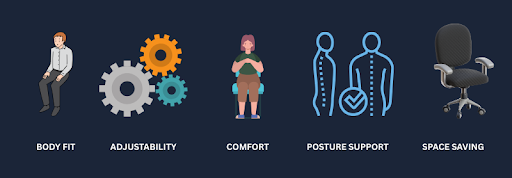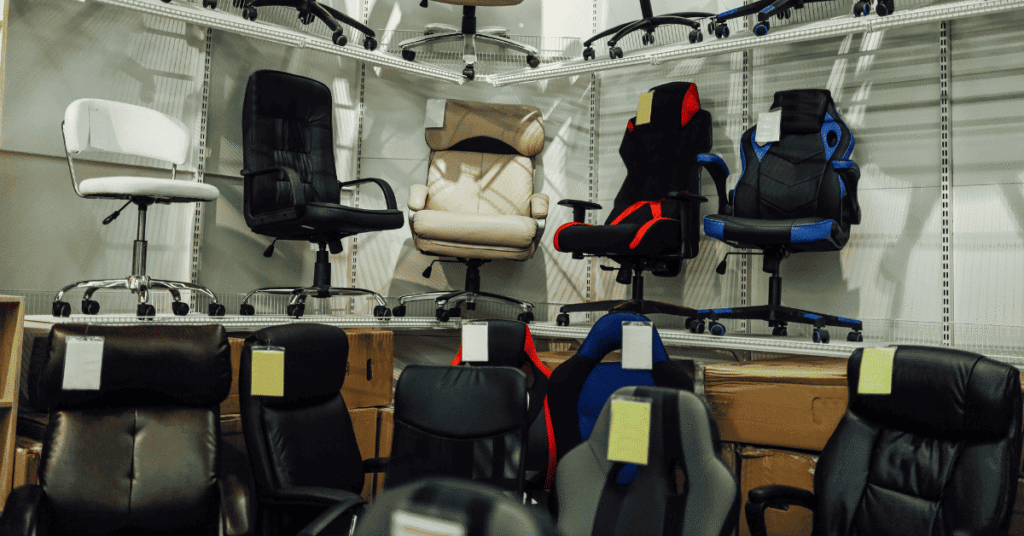
Knowing several types of chairs is essential, as not all chairs are made for the same usage. Depending on the work environment, postural requirements, and length of usage, task chairs, executive chairs, drafting chairs, and ergonomic chairs each serve particular purposes. Selecting the incorrect kind might cause discomfort, decreased concentration, and even long-term medical problems, including bad circulation or back pain.
You improve comfort and productivity when you adapt the chair type to the job function, that is, when you use drafting stools for raised workstations or ergonomic chairs for prolonged desk work. Apart from helping your posture, the correct chair enhances your capacity for concentration and effective performance all through the day.
In addition to comfort but also for efficiency and long-term value, knowledge of several chair types is vital. Every style of chair, task chairs for daily desk work, ergonomic models for posture support, and drafting chairs for raised workstations, is intended with particular usage in mind. Choosing the wrong one might cause discomfort, tiredness, and even medical problems, compromising output.
Table of Contents
ToggleWhy Chair Categories Matter

Workplace ergonomics play a vital role in overall health and productivity, especially considering that Americans spend an average of 6.5 to 8 hours seated daily, according to Medical News Today. Prolonged sitting is linked to serious health risks like heart disease, type 2 diabetes, and even certain types of cancer. While the Mayo Clinic recommends 60-75 minutes of daily moderate aerobic exercise to counteract these risks, the type of chair you use can significantly reduce physical strain during work hours.
Unlike standard office chairs that often lack flexibility, ergonomic chairs are designed to support healthy posture, reduce fatigue, and minimize discomfort over time. Choosing the right chair tailored to your job role helps prevent chronic pain while boosting focus and endurance throughout the workday.
Beyond comfort, chair design also impacts the long-term value and aesthetics of your workspace. For instance, executive chairs offer a professional presence in client-facing roles, while minimalist task chairs complement open-plan layouts with a clean, streamlined look. Picking the right style not only improves employee morale and productivity but also ensures you’re making a smart, lasting investment.
Ergonomic Chairs
Designed to maintain the natural posture of the body and ease strain during extended sitting hours, ergonomic chairs Professionals who spend all day at a desk will find them perfect with lumbar support, changeable height, and tilt tension.
Top models are the Herman Miller Aeron for its flexible arm support, the Steelcase Leap for dynamic lumbar movement, and the breathable mesh and size choices of the Steelcase Gesture. Depending on body type and technique of work, each meets distinct needs.
Task Chairs
Made for short to moderate periods of sitting, task chairs are simple, utilitarian office chairs. Usually lacking the sophisticated elements found in ergonomic versions, such as adjustable lumbar support, armrest depth, or dynamic tilt mechanisms, they usually offer adjustable height, a swivel base, and basic back support.
Task chairs are more affordable and compact than ergonomic chairs, which give long-term posture and comfort with more customization as top priority. Startups, small teams, and small homes where space and money are limited but mobility and general comfort are still crucial choose them since this makes them a great fit.
Executive Chairs
Usually made with an opulent appearance, soft padding, and premium materials like leather or imitation leather, executive chairs are high-back office chairs. Often considered as a status symbol in business environments, they are supposed to exude professionalism and authority while offering comfort with enough cushioning and wide seating.
But missing the adaptability of real ergonomic models, executive chairs sometimes put design above complete ergonomic support. They also typically cost more and could cause discomfort over time because of heat retention from either non-breathable fabrics or dense padding. These aesthetically first chairs might not provide the long-term comfort and adaptability consumers who concentrate on posture and extended hours of sitting need.
Conference Chairs
Usually having a sleek, simple design with little changeability, conference chairs are made with simplicity and style in mind. Their frequently fixed armrests, restricted recline, and regular seat height help to keep their appearance consistent around conference tables, unlike those of ergonomic or task chairs.
These chairs are meant for meetings and shorter times of use when mobility and long-term posture support are less of a concern. Although their neat appearance adds professionalism, they might not be comfortable enough for long seated sessions.
Gaming Chairs
Gaming chairs often attract professionals who appreciate their bold aesthetics, built-in neck and lumbar pillows, and deep recline capabilities. Inspired by racing-style seats, they’re especially popular among streamers, designers, and remote workers who enjoy a mix of work and play at their desks.
However, despite their visual appeal and comfort for short bursts, gaming chairs typically fall short in long-term ergonomic support when compared to high-end ergonomic chairs like the Herman Miller Aeron. The Aeron offers breathable mesh, a tailored fit by size, and advanced lumbar support, all features designed for all-day use. In contrast, gaming chairs may rely too heavily on foam cushions and fixed support that can lose effectiveness over time.
Accent and Lounge Chairs
Designed mostly for aesthetic appeal and relaxed comfort rather than task-oriented support, accent and lounge chairs More than just utility, these chairs, with their elegant frames, soft cushions, and low-slung profiles, add flair to a room.
Common locations where informal, temporary seating is the purpose are creative offices, waiting rooms, reception spaces, or breakaway lounges. Although they provide a laid-back sitting experience, they usually lack the support and adjustability required for concentrated work or extended hours of sitting.
Stools and Drafting Chairs
Drafting chairs and stools are made for raised workspaces such standing desks, drawing tables, or high-top team spaces. Professionals who alternate between sitting and standing during the day will find them perfect since they usually have a foot ring for support, great height range, and a smaller footprint.
From a health aspect, by promoting greater mobility and lessening of the pressure of extended sitting, these chairs can help to improve posture and circulation. Extended use, especially in the lower back and legs, may cause weariness or discomfort without appropriate back support or padding, though. Not as all-day seating options, they are most suited in concert with sit-stand routines.
Best Chair for Your Needs
Here’s a clear and scannable visual comparison of chair categories, evaluating them by price, comfort, adjustability, and usage duration:
| Chair Category | Price | Comfort | Adjustability | Usage Duration |
|---|---|---|---|---|
| Ergonomic Chair | High | ★★★★★ Excellent | ★★★★★ Highly adjustable | 8+ hours |
| Executive Chair | Medium–High | ★★★★☆ Plush | ★★☆☆☆ Basic-adjust | 4–6 hours |
| Task Chair | Low–Medium | ★★★☆☆ Moderate | ★★☆☆☆ Limited | 2–4 hours |
| Conference Chair | Low–Medium | ★★☆☆☆ Basic | ★☆☆☆☆ None | 1–2 hours (meetings) |
| Accent/Lounge Chair | Medium | ★★★★☆ Cozy | ★☆☆☆☆ None | <1 hour (casual use) |
| Gaming Chair | Medium–High | ★★★★☆ Plush | ★★★☆☆ Moderate adjust | 4–8 hours (varies) |
| Stool/Drafting Chair | Low–Medium | ★★☆☆☆ Firm | ★★☆☆☆ Seat-height only | 2–4 hours (sit-stand) |
Summary Insights:
- Although they are more expensive, ergonomic chairs are first choice for all-day work.
- Perfect for shorter use, executive chairs provide soft comfort with minimum change.
- Task and conference chairs may not encourage excessive hours but strike a reasonable mix for the budget.
- Lounge chairs excel in style and temporary relaxation.
- Gaming chairs lack breathable materials for extended use, yet they combine style with mild ergonomics.
- Great for flexible sit-stand configurations, stools and drafting chairs are not meant for lengthy sitting.
This table helps you make decisions based on how long you sit, your adjustability needs, and how much you are ready to spend for support and comfort!
What to Consider When Choosing a Chair

Finding the appropriate chair is about fit, support, and purpose more than only appearance. First, take some thought on your body shape since different chairs provide diverse seat depths, widths, and backrest heights. Then consider your everyday usage time. Should you spend six to eight hours or more sitting, you will want a chair with sophisticated ergonomic design. Your desk height also matters; your chair should let you sit with your feet flat on the floor, knees at a 90-degree angle, and elbows level with the surface. Finally, evaluate your lumbar support requirements. Invest in a chair with movable lumbar support if you have lower back discomfort or tiredness to help you keep correct spine alignment.
✔️ Ergonomic Chair Checklist:
- Seat height and depth adjustment
- Adjustable lumbar support
- Tilt and recline tension control
- Adjustable armrests (height and pivot)
- Breathable material (e.g., mesh)
- Smooth-rolling casters and stable base
- Proper weight capacity for your build
By matching your chair to your body and work style, you’ll increase comfort, reduce strain, and boost productivity throughout your day.
Conclusion
Choosing the right chair means considering how long you sit, your body type, and what kind of support you need. Ergonomic features like adjustable seat height, lumbar support, and armrest flexibility play a huge role in maintaining comfort and preventing strain. Whether you’re outfitting a home office, conference room, or creative space, matching the chair category to your work style is essential.
If you’re looking for both comfort and value, refurbished ergonomic chairs, like the Herman Miller Aeron, offer a smart alternative to buying new. You get premium quality, full adjustability, and long-lasting support at a fraction of the original price, making them a cost-effective investment in your health and productivity.
FAQs:
What are the main categories of office chairs?
The main categories of office chairs include ergonomic chairs, task chairs, executive chairs, conference chairs, gaming chairs, lounge chairs, and drafting stools. Each serves different comfort, style, and usage needs.
How is a task chair different from an ergonomic chair?
A task chair offers basic comfort and limited adjustability, ideal for short to moderate use. An ergonomic chair provides advanced support and customization, improving it for long hours and posture health.
Are gaming chairs good for office work?
Gaming chairs can be used for office work, but they often prioritize style and recline over long-term ergonomic support. For all-day comfort, a true ergonomic chair is usually a better choice.
What chair is best for sitting all day?
An ergonomic chair is best for sitting all day. It offers adjustable lumbar support, seat height, armrests, and tilt to keep you comfortable and reduce strain during long hours.
Which chair category is the most budget-friendly?
Task chairs are the most budget-friendly category. They offer basic support and functionality, making them ideal for short-term use or compact workspaces.
Looking for the perfect chair that balances comfort, function, and budget?
Shop now and save up to 50%!



